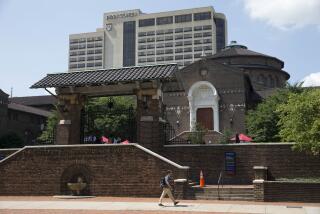A S. African Native’s Homecoming
JOHANNESBURG, South Africa — The remains of Saartjie Baartman, a native Khoisan woman exhibited in Europe nearly two centuries ago as an ethnological and sexual freak, were returned Friday to South Africa amid celebration.
“We’re proud to welcome her back where she belongs and hope that she will be buried in a spirit of reconciliation,” Andries le Fleur, paramount chief of the Griquas, a subgroup of the Cape Town region’s Khoisan people, said at an emotional “homecoming” ceremony.
A wooden box containing Baartman’s preserved brain, sexual organs and skeleton was draped in a South African flag and flanked by six Khoisan children as it was wheeled into the Cape Town airport building where local dignitaries waited to pay their respects.
A rug of antelope and zebra skins was rolled out in Baartman’s honor. A group of Khoisan chanted, sang and played traditional instruments.
Proponents of returning Baartman’s remains from Paris hailed the move as a triumph of the human spirit and a significant step toward restoring dignity to indigenous people worldwide. The Khoisan, considered the original inhabitants of Africa’s southern tip, suffered atrocities at the hands of successive colonial rulers.
“The return of Saartjie Baartman is going to give rise to the rediscovery of the pride of the Khoisan people,” said Petrus Marais, premier of Western Cape province, who is also of Griqua heritage. “This is not the coming of one person--it is the coming of a nation.”
“It’s a victory for human rights,” said Griqua leader Sammy Jansen. “Now that we have gotten her back, we are very satisfied.”
The Khoisan consist of two ethnic groups, the Khoikhoi and the San. Thousands of Khoisan died of smallpox or were displaced following the arrival of Dutch settlers in the 17th century.
Typically honey-colored in complexion, most Khoisan were absorbed into the so-called colored population under South Africa’s apartheid-era system of racial classification.
Of curiosity to Europeans in Baartman’s day were her large genitalia and protruding buttocks, anatomical characteristics particular to the Khoisan--who were derogatorily referred to as “bushmen” or “Hottentots.”
Khoisan leaders said they hoped that publicity about Baartman’s ordeal would serve as a lesson to future generations to ensure that such mistreatment is never repeated. They would also like her story to ignite a continent-wide drive to have other elements of Africa’s lost heritage repatriated.
A delegation led by Brigitte Mabandla, South Africa’s deputy minister of arts, culture, science and technology, went to Paris to collect Baartman’s remains, which will be stored at a military mortuary until an appropriate burial is arranged. Mabandla said a monument probably will be built.
Baartman was born near the Gamtoos River valley in the eastern Cape region in 1789. In 1810, a British navy doctor convinced her that she could make a fortune displaying her body to curious Europeans, and he took her to London.
“She was taken, not against her will, but under false pretenses, by unscrupulous men,” said Dr. Willa Boezak, national chaplain for the Khoisan community.
Dubbed the “Hottentot Venus,” Baartman was paraded around Britain at circus sideshows, museums, bars and universities. Considered to be part animal, she was kept in a cage and made to sing and dance in public, as people paid to gawk at her.
Marilyn Martin, director of art collections at Iziko Museums of Cape Town, said European scientists used Baartman’s figure to perpetuate vulgar stereotypes about race and African sexuality and to support claims that blacks were inferior.
“People like Saartjie would have been relegated to the very bottom of the evolutionary ladder,” Martin said. “Europeans had decided what was the acceptable civilized norm.”
The British press and the anti-slavery movement at the time fought in court for Baartman’s release, but the case was thrown out when she testified that she was in London of her own free will. She also told the court that she was happy, which Khoisan leaders believe was a lie.
“If we can put ourselves in her shoes as a lonely woman at the mercy of these men, Saartjie had to put up with a lot from these people just to survive,” said Boezak, the chaplain. “It was a strategy of survival.”
Baartman was later taken to Paris for exhibition. Historians say she drifted into prostitution and died in poverty in 1816.
“We suspect that her untimely death at such a young age was partly [due to] psychological [issues],” Boezak said.
Mystery still surrounds the fate of two children Baartman is said to have had with a West Indian man she married in England.
After her death, a French surgeon made a mold of her body. Her brain and genitalia were bottled as specimens for scientific study, while the painted plaster cast of her body was displayed at the Museum of Mankind in Paris until 1974. It was then stashed in a back room, along with her remains.
In 1995, representatives of the South African government and the Khoisan initiated talks with France about returning her remains for burial.
In January, a French senator took up Baartman’s cause. Her remains being the legal property of the state, it took a special act of Parliament to allow them to be returned to South Africa.
“Now that an historical injustice has been righted,” Boezak said, “she has become a symbol of freedom for our women.”
More to Read
Sign up for Essential California
The most important California stories and recommendations in your inbox every morning.
You may occasionally receive promotional content from the Los Angeles Times.










